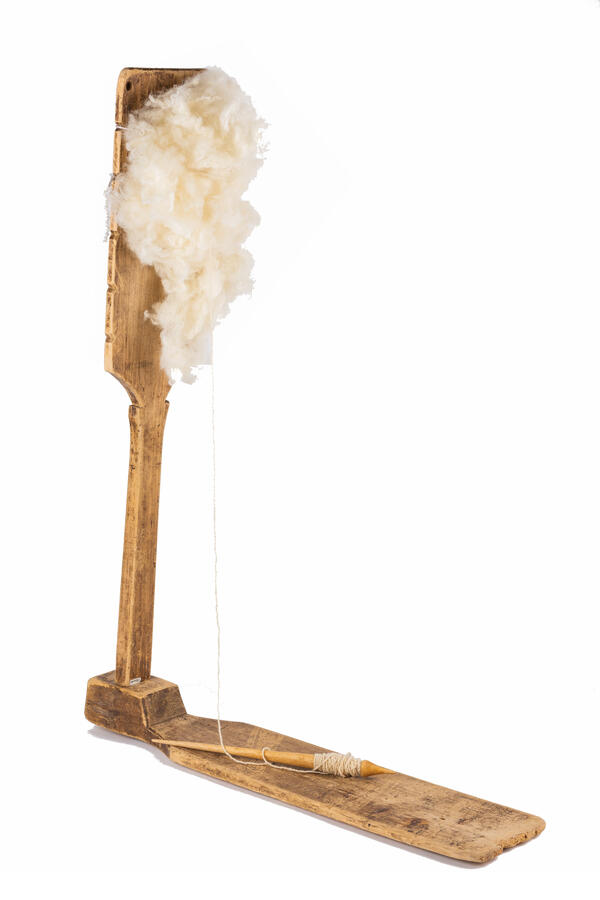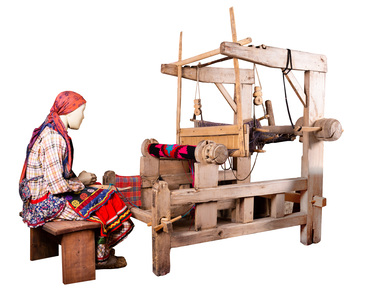Since ancient times, the spindle and distaff have been tools used to produce yarns. A wooden distaff has a simple design, and is a device that is easy to master, which enabled it to spread on a wide scale across different eras, and among the peoples in many countries. In terms of its design, there are two main types of distaffs: multipart (assembled from several separate parts) and one-piece (made from the root and trunk of a tree). The museum’s collection showcases a multipart distaff made in the XX century. It consists of a horizontal bottom, where the distaff sat, and a vertical blade to which the tow was attached, which is flax fiber cleaned of solid particles.
The blades on ancient spinning wheels from the 13th – 15th centuries had a simple, austere form, most often rectangular or leaf-shaped, with several holes. In Russia, in the northern and central regions, distaffs with combs were often used to spin threads from plant fibers. Distaffs were often richly decorated with paintings or carvings, and were sometimes colored. Periodically, carving and painting were combined: these distaffs became stand-alone works of functional art. After they could no longer do work, decorated distaffs were usually hung on the wall, or placed in a prominent place: they served as a full-fledged decoration in a hut.
In addition to one-piece and multipart distaffs, there are also portable varieties. In these distaffs, the tow was tied or pinned to one end of it (if it was flat), or put on top of it (if it was sharp), or fastened in some other way (for example, in a flyer). The other end was inserted into a belt — and the woman, holding the distaff with her elbow, worked while standing, or even on the move, while walking in the field or working with domestic livestock.
Regardless of the type of distaff, the craftswoman always repeated the same movements: with the fingers of one hand, she pulled out several fibers of the tow and twisted them, while with the other she turned the spindle, winding the thread around it. At the end of the work, the spindles with threads wound on them were placed in a round bast box. The spindles were also made if fairly regimented shapes and sizes: wooden sticks that were smooth, cigar-shaped, narrowed at the ends, about 26 cm long, and about 10–12 mm in diameter in the middle part.
The blades on ancient spinning wheels from the 13th – 15th centuries had a simple, austere form, most often rectangular or leaf-shaped, with several holes. In Russia, in the northern and central regions, distaffs with combs were often used to spin threads from plant fibers. Distaffs were often richly decorated with paintings or carvings, and were sometimes colored. Periodically, carving and painting were combined: these distaffs became stand-alone works of functional art. After they could no longer do work, decorated distaffs were usually hung on the wall, or placed in a prominent place: they served as a full-fledged decoration in a hut.
In addition to one-piece and multipart distaffs, there are also portable varieties. In these distaffs, the tow was tied or pinned to one end of it (if it was flat), or put on top of it (if it was sharp), or fastened in some other way (for example, in a flyer). The other end was inserted into a belt — and the woman, holding the distaff with her elbow, worked while standing, or even on the move, while walking in the field or working with domestic livestock.
Regardless of the type of distaff, the craftswoman always repeated the same movements: with the fingers of one hand, she pulled out several fibers of the tow and twisted them, while with the other she turned the spindle, winding the thread around it. At the end of the work, the spindles with threads wound on them were placed in a round bast box. The spindles were also made if fairly regimented shapes and sizes: wooden sticks that were smooth, cigar-shaped, narrowed at the ends, about 26 cm long, and about 10–12 mm in diameter in the middle part.



